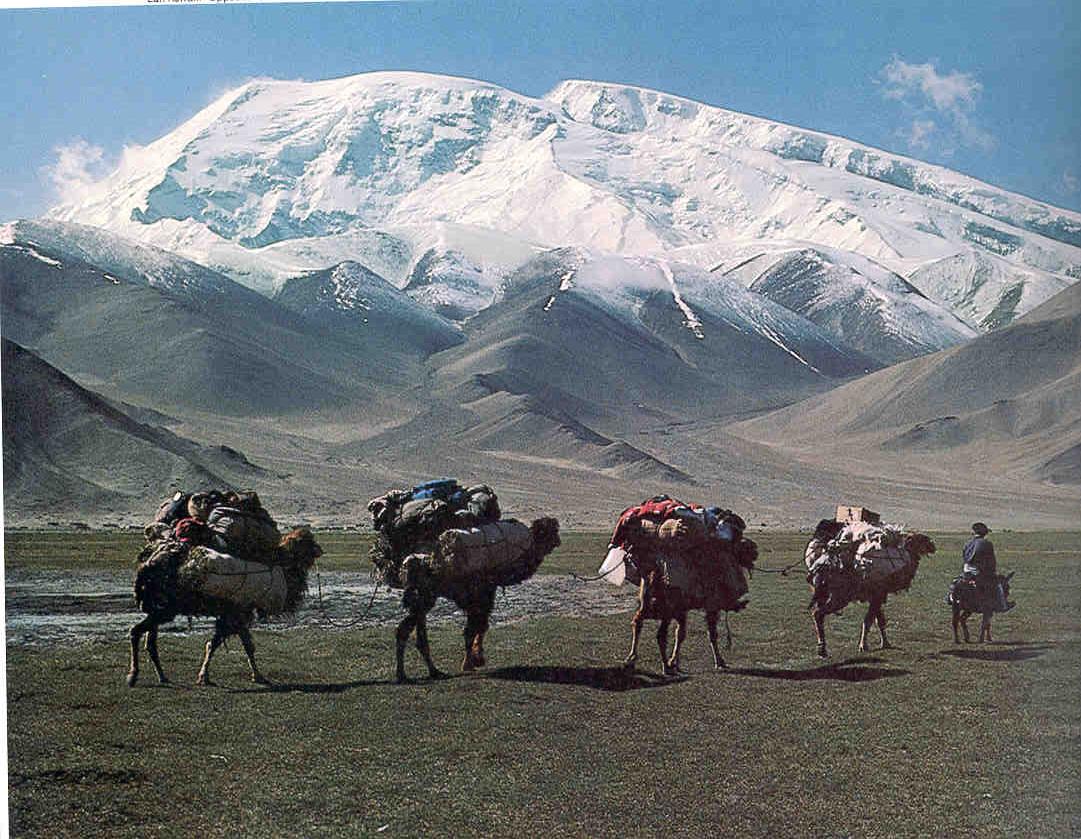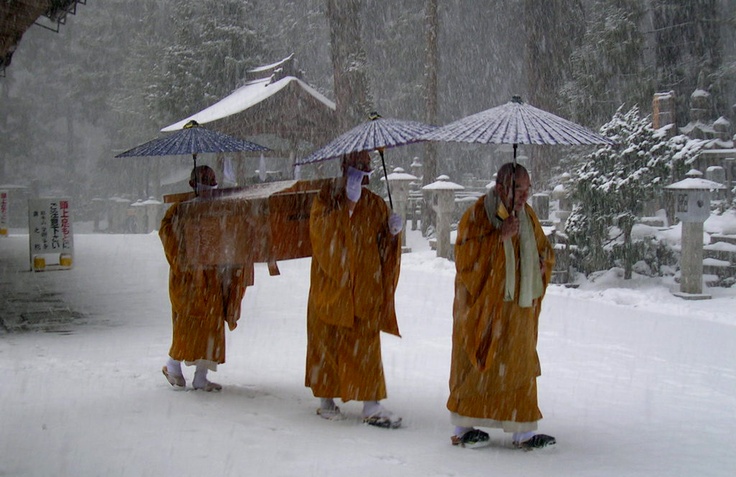RELG 402 - World's Living Religions
Buddhism in Japan
Click on the Thumbnails to see larger pictures
Hover the mouse over a Thumbnail to see the caption
History
Buddhism first arrived in Japan in the 6th century AD (ca. 538 or 552), from China and Korea. The Korean king sent the Japanese emperor a picture of the Buddha and some sutras. This was a period when there was much immigration from Korea, and also cultural influences from China.
 Buddhism had traveled from India to China along the Silk Road - the trading routes between China and the West. Silk and spices were carried by stages to Indian, Mediterranean, and European markets - changing hands between a variety of merchants along the way. Amber (from the Baltic), and slaves, were traded Eastwards. Along with the exchange of merchandise, there was an exchange of ideas, and both Buddhism and Christianity moved Eastwards along the trading routes.
Buddhism had traveled from India to China along the Silk Road - the trading routes between China and the West. Silk and spices were carried by stages to Indian, Mediterranean, and European markets - changing hands between a variety of merchants along the way. Amber (from the Baltic), and slaves, were traded Eastwards. Along with the exchange of merchandise, there was an exchange of ideas, and both Buddhism and Christianity moved Eastwards along the trading routes.
 The person credited with bringing Buddhism from India to China is Bodhidharma (or Budhidharmo), who is said to have meditated for such long periods that his arms and legs atrophied, so that his disciples had to carry him from place to place wrapped in a blanket. Bodhidharma is also credited with initiating the physical training for monks that developed into Kung Fu. From China, Buddhism spread to Korea, and then across the sea to Japan.
The person credited with bringing Buddhism from India to China is Bodhidharma (or Budhidharmo), who is said to have meditated for such long periods that his arms and legs atrophied, so that his disciples had to carry him from place to place wrapped in a blanket. Bodhidharma is also credited with initiating the physical training for monks that developed into Kung Fu. From China, Buddhism spread to Korea, and then across the sea to Japan.
Until Buddhism and Buddhist texts came to Japan the Japanese had no system of writing. The initial texts were written in Chinese, and Japanese scholars learnt to read and write in Chinese, then adapted and simplified the Chinese characters for their own language. The Chinese and Japanese languages are quite different from one another, both in vocabulary and grammar, so the Japanese developed a second set of characters for use with Japanese grammatical constructions - these characters are simpler than those derived from Chinese, and are know as Hiragana. When Japan opened to Western influences a third set of phonetic characters for consonant-vowel pairs was invented; these are even simpler, and are used for foreign names, chemical compounds, etc.; they are called Hiragana.
Buddhism was first brought to Japan by five Chinese monks in 467 AD. They settled in the region of Fusang and began to teach Buddhist doctrine to the local population.
However, the official date for the introduction of Buddhism to Japan is 552 AD, when the King of Korea sent a mission of Buddhist monks and nuns with a statue and some scrolls to the Japanese court at Nara. They were befriended by powerful Japanese, and eventually by Prince Shotoku Taishi and the Empress. Japanese aristocrats started building Buddhist temples in Nara (the state capital) and then in the later capital, Heian (now Kyoto).
Six Buddhist sects were established in Nara, and still exist as "Nar Buddhism", but they are relatively minor and local.
More Buddhist groups arrived from China when the court moved to Heian, these included Shingon Buddhism (similar to Tibetan Buddhism) and Tendai Buddhism (a monastic conservative form).
The Shogunate came to power in the 12th century, and more forms of Buddhism entered the country, including two schools of Zen Buddhism, Rinzai and Soto. A third school arrived in 1661.
In the 13th century Nichiren Buddhism was established by the monk Nichiren. He stressed the Lotus sutra and the chanting of the phrase "Nam Myōhō Renge Kyō". Nichiren sects today include Nichiren Shū, Nichiren Shōshū, Risshō Kōsei Kai and Soka Gakkai, a controversial sect which meddles in politics and whose members form the third largest political party in Japan.
The Tokugawa government required every family to register as members of a Buddhist temple, but this was changed by the Meiji Restoration to the requirement to become a member of a Shinto shrine.
The Shogunate was defeated and Imperial rule was restored by the Meiji Restoration in 1868. Japan was modernized to some extent, Shinto was made the state religion, and attempts were made to eliminate Buddhism and Buddhist influences on Shinto. The attempts were not successful.
Pure Land Buddhism arrived in the Kamakura period. It focuses upon Amitabha Buddha and teaches that by reciting the phrase "Namu Amida Butsu" ("I take refuge in Amida Buddha") at death one will be taken by Amitabha to the Western Paradise or "Pure Land", and then to Nirvana. Pure Land Buddhism split into two schools : Jōdo-shū, which focuses on repeating the phrase many times, and Jōdo Shinshū, which claims that it is only necessary to saying the phrase once, with a pure heart. Today, many Japanese are members of Nishi Honganji-ha, a conservative sect of Jodo Shinshu.
Zen Buddhism is a form of Buddhism which developed in Japan. It stresses Zazen (meditation) more than other forms of Buddhism.
The largest new religion is Soka Gakkai, a Buddhist sect founded in 1930, which has about 10 million members in Japan.
About a third of the present population of Japan identify themselves as Buddhist - but many of them also observe some of the Shinto and other rituals and holidays.
 More than 90% of Japanese funerals are carried out according to Buddhist traditions, often with a Buddhist priest officiating.
More than 90% of Japanese funerals are carried out according to Buddhist traditions, often with a Buddhist priest officiating.
Ancestors are revered and a Buddhist ceremony may be performed on the anniversary of the death of a family member.
 Japanese families usually celebrate the holiday of Obon by setting up a "Spirit Altar" (bon) in front of the family Buddhist altar, by cleaning family graves for the return of the spirits, and by floating lanterns and traditional dances. This is a time for family members to return to their ancestral homes and visit with relatives. The family will usually visit a Buddhist temple for prayers, and may also carry out rituals in the home.
Japanese families usually celebrate the holiday of Obon by setting up a "Spirit Altar" (bon) in front of the family Buddhist altar, by cleaning family graves for the return of the spirits, and by floating lanterns and traditional dances. This is a time for family members to return to their ancestral homes and visit with relatives. The family will usually visit a Buddhist temple for prayers, and may also carry out rituals in the home.
![]()
Time Line
538 or 552 (accounts very) - Buddhism entered Japan from Korea.
574-622 - Prince Shotoku became a Buddhist, promoted Buddhism, built many temples, and introduced Buddhist and Confucian systems of ethics, court administration, and bureaucracy.
645-646 - After a period of court intrigues and coups the imperial family came back to power and instituted the Taika Reforms. The court moved to Osaka, built more Buddhist temples, and imported more monks and nuns from China.
710-794 - The Nara Period - The court moved to Nara, and Emperor Shomu established a system of Buddhist monasteries and nunneries throughout the nation, all under the direction of the Todaiji Temple in Nara.
766-833 - Saicho, Japanese Buddhist priest who traveled to China and returned to Japan to found Tendai Buddhism.
774-835 - Kukai, Japanese Buddhist priest who traveled to China and returned to found Shingon Buddhism.
794-1185 - The Heian Period - The monasteries in Nara were meddling in court politics, so the court moved to Kyoto. Shinto beliefs were incorporated into some of the Buddhist schools. Religious pilgrimages were started.
1185-1332 - The Kamakura Period - after years of political turmoil Minamoto Yoritomo established the Kamakura shogunate (military and political power) in Kamakura. The Emperor and the Imperial court were still at Nara, but were religious figures without military power. The military class of Samurai and the Shoguns were the real powers in the land. However, it was during this period that Buddhism spread to the common people, and Pure Land, Zen, and Nichiren Buddhism developed. Folk Buddhism began to worship deities such as Amida and Kannon.
1133-1212 - Honen, co-founder of Pure Land Buddhism, which teaches dependence and faith on Amitabha
1173-1262 - Shinran, co-founder of Pure Land Buddhism
1141-1215 - Eisai, co-founder of Soto Zen and Rinzai Zen, which teaches liberation of the self through meditation
1200-1253 - Dogen, co-founder of Soto Zen and Rinzai Zen
1222-1282 - Nichiren, founder of Nichiren Buddhism, which teaches devotion to the Lotus sutra
1392-1573 - The Muromachi Period, marked by continuous civil wars. Some of the Buddhist monasteries and temples were destroyed in the fighting, and lost thier political power, but the warrior class adopted Zen Buddhism.
1534-1582 - Oda Nobunga, warlord who overthrew the Muromachi Bakufu in 1573
1536-1598 - Toyotomi Hideyoshi, successor to Oda Nobunga, unified Japan ca. 1590, banned Christianity and executed 26 Franciscan missionaries in 1597.
1542-1616 - Tokugawa Ieyasu, successor to Toyotomi Hideyoshi, founded the Tokugawa Shogunate, centered on Edo, which remained in power for 250 years.
1615-1868 - The Edo Period, when Japan was controlled by 15 generations of the Tokugawa shoguns in Edo, and the Emperor was a mere religious figurehead. Neo-Confucianism was imported from China, and Buddhism declined.
1659 - All Japanese families were ordered to register with Buddhist temples (in order to stop the spread of foreign religions). Japanese Christians were killed or went into hiding, concealing their faith under what appeared to be Buddhist practices.
1868 - Meiji Restoration - the Emperor gained power over the Shogunate, and moved the court from Kyoto to Edo (now Tokyo).
1868 - Commodore Perry forced the Meiji leaders to allow Westerners to enter Japan, bringing trade, commerce, and new ideas into the country.
1868-1912 - The Meiji Period. Shinto, including Emperor worship, was made the state religion. Buddhism was declared to be a foreign superstition, and there were anti-Buddhist riots and mob violence. Nevertheless, Buddhism survived, by purging superstitions, and after WWII there were 13 main Buddhist sects and about 100 sub-sects of Buddhism in Japan.
1872 - Japanese edict ended Buddhist principals as the foundation of state law, and allowed Buddhist priests to marry and to eat meat. State Shinto took prominence over Buddhism.
1930 - Soka Gakkai founded, as a Lay organization of Nichiren Buddhism ("Nichiren minus his combativity"). During WWII the leaders were imprisoned and starved, but at the end of the war the one surviving leader was released and rebuilt the organization.
Copyright © 2015 Shirley J. Rollinson, all Rights Reserved